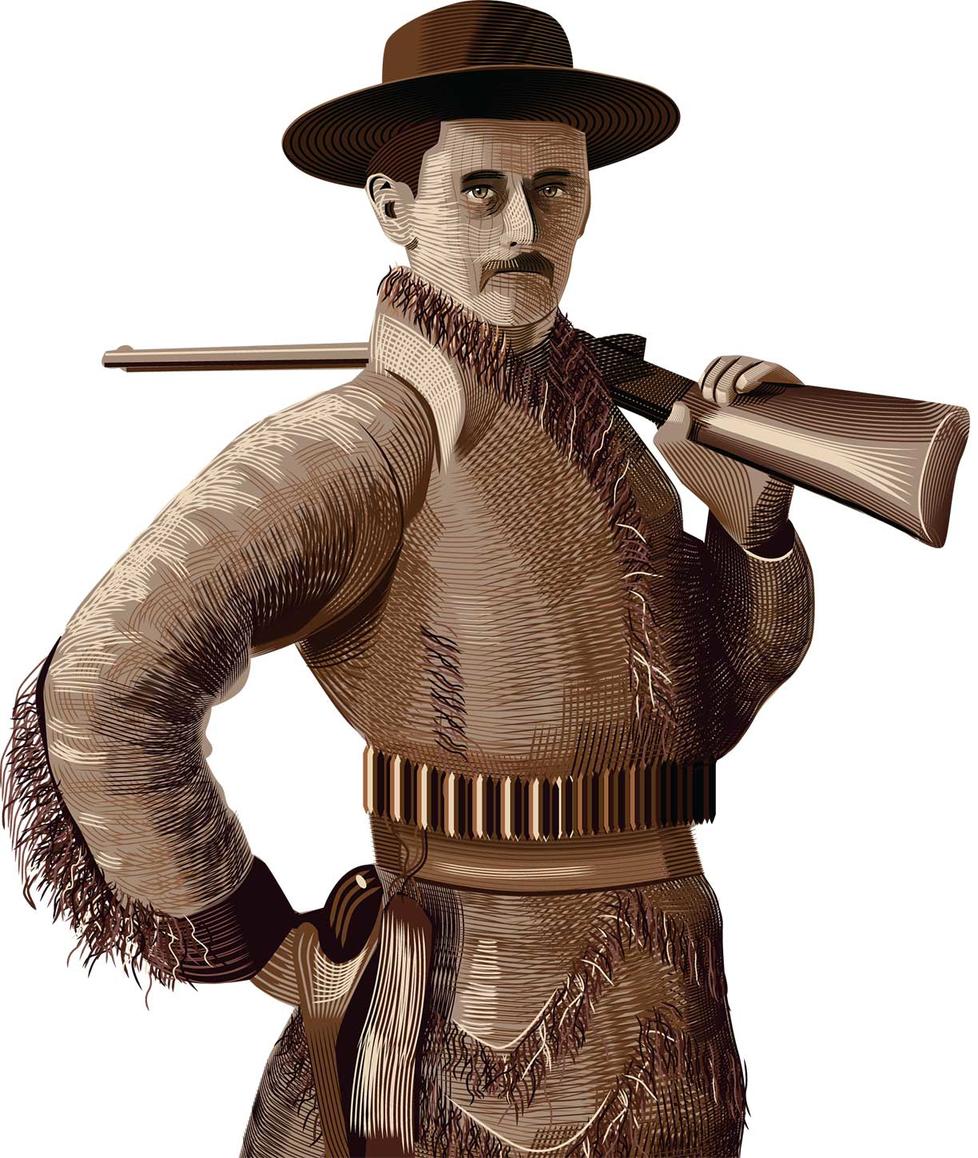Sculptor of Nassau Hall’s Bronze Tigers Was a Cowboy
Princeton Portrait: Alexander Phimister Proctor (1860–1950)
The bronze tigers outside Nassau Hall are a legacy of the Old West. Their sculptor, Alexander Phimister Proctor, hailed from a time of rugged bravery and experimentation, a time when you could name your child Phimister and he wouldn’t even be angry about it.
When Proctor was 3, his family felled hickory trees, bent the trunks into bows, and used them for the top of a covered wagon, which they drove from the Canadian woods down into the United States. For eight years, they roamed the prairies before settling for good in Denver. In a memoir, Proctor recalled the Denver of the 1870s: “Trappers, cowboys, and dirty-clothed prospectors were familiar sights on the few sagging wooden sidewalks. Huge charcoal wagons with yokes of oxen filled the streets. Covered wagons were to be seen at any time of day or night. Saloons and gambling halls flourished. Frequently, herds of longhorns were driven through town.”
The brooks were dry on the day of his baptism — a traveling preacher came to town, crying, “The Devil’s hot on your trail! You got to repent, and I’m here to rope you and drag you into the fold of God.” Young Proctor volunteered as a repentant sinner, so he was baptized in a tank of sheep dip, a stinging insecticide. Proctor kept his religion anyway, and he avoided cigars and liquor throughout his life.
In the summers, he liked to go big-game hunting with President Teddy Roosevelt, who was eager to skip dull meetings in favor of what Roosevelt called the “spice of danger.”
From youngest childhood, he wanted to be an artist, so his father hunted down books and read about the history of art. “Father’s reading in art literature was mostly about the Greeks and the Italians. His ideal sculptors were Phidias and Michelangelo, and he showed me pictures of their work,” Proctor wrote in his memoir. The literature said artists are often poor, so his father had him apprentice to an engraver; he could always sell thrilling illustrations to newspapers. His first commission was to illustrate a book on true crime by a sheriff who ran a local saloon. The pictures include a bloodbath at a card game, a horseback chase in the mountains, and the wedding of a man who stole money and faked his death so he could remarry, only to be robbed and abandoned in turn by his new wife.
In 1885, Proctor moved to New York City to study, in the Metropolitan Museum of Art, the classical sculptures that his father loved so much. By 1909, when Princeton’s Class of 1879 commissioned Proctor to create the Nassau Hall tigers to replace the pair of lions the class had contributed earlier, he was an award-winning sculptor who specialized in wild animals, like the bears and buffalo that roamed the West. In the summers, he liked to go big-game hunting with President Teddy Roosevelt, who was eager to skip dull meetings in favor of what Roosevelt called the “spice of danger.”
For his models, Proctor chose two tigers in the Bronx Zoo, Rani and Rajah. (The zookeepers used to put leather booties on Rajah so he could walk around a nearby park.) “The bronze had to be thick enough to withstand the treatment undergraduates would give the statues,” Proctor said. He attended the dedication ceremony on Commencement Day, 1911: “Standing on the platform in front of Nassau Hall, flanked by the statues, Margaret [his wife] and I were introduced by President Wilson and honored with the Princeton yell.”
Rani and Rajah’s descendants included a cub named Princeton.











1 Response
Laura Proctor Ames
4 Years AgoNassau Hall’s Beloved Tigers
A friend shared Elyse Graham ’07’s article about Alexander Phimister Proctor (Princeton Portrait, March issue), the sculptor who created the two Princeton tigers in front of Nassau Hall in 1911, and also my great-grandfather. He had an adventurous life — he was a cowboy and an artist, outdoorsman, and homesteader, and nicknamed himself “the sculptor in buckskin” (also the title of his autobiography).
For many years, my 83-year-old father and I have encouraged the University to conserve the two historic sculptures so that they can continue to greet students, staff, and visitors for many years to come. The campus has an incredible collection of public art, so Proctor’s tigers have not yet become the priority for conservation. Unfortunately, the historic bronze metal and patina are deteriorating due to many years of exposure to the elements, bird droppings, and energetic, climbing children! Each year that goes by, the artist’s original work is in jeopardy. The Proctor family is committed to sharing Proctor’s legacy, and helping maintain his monumental historic works across the country. Please save these museum-quality, historic sculptures!
Editor’s note: Bart Devolder, chief conservator at the Princeton University Art Museum, provided the following comment on the Proctor sculptures: “As with all campus art at Princeton, we have been watching these Tigers closely. A scheduled refurbishment by an out-of-state conservator suggested by the Proctor Foundation had to be postponed due to COVID-19 restrictions, but please know that the works are not in danger. Various treatment options, including how to address the rubbed (indeed well-loved, as you say) areas and the preferred patina, have been considered, and conservation will go forward as soon as circumstances allow.”